cribbing collar
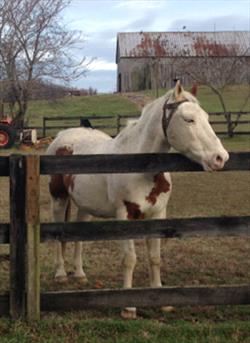
This horse is wearing a cribbing collar. Image courtesy of Mary Klinck. PhD, DVM, DACVB
What is Cribbing?
Cribbing is also called crib-biting, or wind-sucking. A horse typically uses a fixed, horizontal object (like a fence rail, or the edge of a feed tub), to crib. First, they grab hold of the object with their upper front teeth (incisors). Next, they press downward and pull back, arching their neck and drawing air into their upper esophagus. This makes a characteristic burping or grunting sound. A horse may use different objects for cribbing, depending on what is available. Often, they lick and mouth the object before cribbing on it. Some horses are able to crib without even grasping an object.
The series of photos below show the sequence:
cribbing photo a
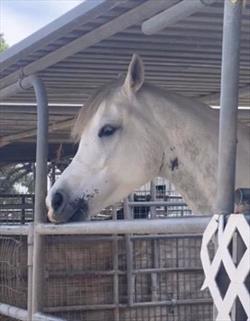
Image A: The horse puts his upper incisors against the metal bar. Image courtesy of Mary Klinck. PhD, DVM, DACVB
|
cribbing b
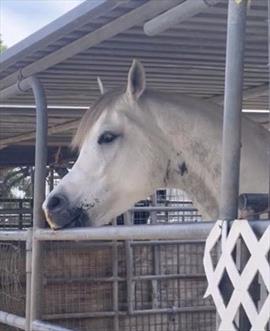
Image B: He presses down, beginning to arch his neck. Image courtesy of Mary Klinck. PhD, DVM, DACVB
|
crc.jpg
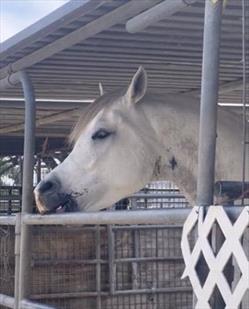
Image C: He pulls back, arching his neck and pressing down and back against the fence with his upper incisors. Image courtesy of Mary Klinck. PhD, DVM, DACVB
|
cribbing d
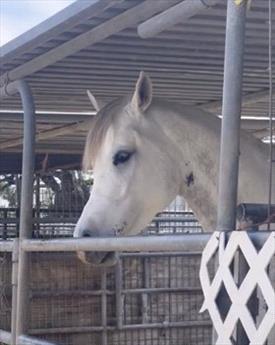
Image D: Then, he releases the bar. Image courtesy of Mary Klinck. PhD, DVM, DACVB
|
It is common for a horse to crib repeatedly, in one session. Here is a video example of the same horse doing this while chewing grain:
Cribbing is a stereotypy. This means that the horse does it over and over, pretty much the same way every time, and that it doesn’t have any obvious purpose. It can become a compulsive behavior. This means that the horse wants to do it, even in different contexts than the one in which the cribbing started. For instance, some horses who started cribbing in a stall will continue to do it even at pasture.
Cribbing used to be considered a “vice”, meaning an undesirable behavior, or even an unsoundness. This is changing as we learn more.
Why Do Horses Crib?
Cribbing hasn’t been observed in free-ranging wild or feral horses. It is seen in domestic horses and has also been seen in captive Przewalski horses.
It used to be thought that horses learned to crib from watching other horses do it. It turns out that this is not typically how cribbing starts. However, cribbing is more likely to show up in related horses and in horses that are managed similarly. Thoroughbreds are the breed most likely to crib, followed by Warmbloods. Dressage and eventing horses have been found to be more likely to crib. Male horses, especially stallions, are more likely to crib than mares. Some of these associations may be because of the way these horses tend to be managed. For instance, Thoroughbreds and Warmbloods are often used for dressage and eventing, and housed individually in stalls, and stallions are often kept separate from other horses.
These are management practices that increase the risk a horse will crib:
- Forced weaning (that is, being separated from the mare by humans).
- Increased time in a stall (vs. turned out), particularly in young horses.
- Being kept in an enclosure separate from other horses (limiting social interactions).
- Not having constant access to forage (such as hay or grass).
- Being fed higher amounts of concentrates (grain).
Some horses who crib may have stomach ulcers or increased stomach acidity. Cribbing may decrease when these horses are treated with an antacid. However, the evidence for a cause and effect between stomach ulcers and cribbing is not clear.
There is evidence that cribbing can relieve stress. Many of the management practices listed above are causes of stress in horses.
cribbing wear to teeth
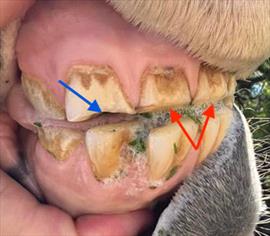
Excessive tooth wear: the upper incisors are abnormally short. Abnormal tooth wear: there is a groove worn in the biting surface one tooth (blue arrow), and the biting surfaces are not flat, but worn at an angle (red arrows). Image courtesy of Mary Klinck. PhD, DVM, DACVB
Is Cribbing Unhealthy for Horses?
Cribbing can cause abnormal and excessive tooth wear. It can also cause changes in muscling of the neck, and it can be associated with arthritis in structures of the jaw/throat (temporohyoid osteoarthritis).
This photo shows abnormal and excessive wear of the upper incisors in the grey horse shown cribbing in the images above:
Should Cribbing Be Stopped?
It is very common for people to try to stop horses from cribbing. This is because of the concerns noted above, and also because cribbing horses can damage fences and other objects that they use.
Stopping cribbing usually involves using:
- Devices put on the horse (such as muzzles, cribbing straps or collars, and cribbing rings),
- Deterrents on the objects used (unpleasant tasting substances, spikes, electrified fencing),
- Surgical procedures (removing parts of the muscles, and sometimes nerves, of the neck).
The motivation to crib is strong. One study found that it was as strong as the motivation to eat. When horses who crib are prevented from doing it:
- They show increased stress levels;
- They crib even more once they are able to do it again (for example, when the cribbing collar is removed).
This suggests that these horses may crib as a coping or self-soothing behavior. Physically preventing them from cribbing does not fix the underlying causes. Instead, it may take away their means of coping with stress or anxiety. It is better to manage horses so that they are not motivated to begin cribbing in the first place, or to reduce their desire to crib, than to physically prevent them from cribbing.
How to Reduce the Motivation to Crib
Keeping the horse in a more natural setting can decrease the drive to crib. Horses naturally live in stable groups, in wide open spaces, and spend much of their time grazing. Ways to mimic a natural lifestyle include:
- Keeping the horse with other horses.
- If the horse can’t be in the same enclosure with other horses, they should at least be able to see other horses and ideally have physical contact with them over the fence.
- Avoid adding or removing horses from the group, as much as possible.
- Minimizing the feeding of concentrates (grain).
- Maximizing access to forage (hay/pasture).
- Providing access to pasture for grazing.
- If grass isn’t available, providing multiple slow-feeding haynets in different locations to encourage horses to eat small amounts frequently, and to move around, mimicking grazing.
Preventing Cribbing
Because cribbing has a genetic component, one way to prevent it is to avoid breeding horses that crib. Prevention also involves keeping horses in more natural environments. It has been shown that minimizing stress around the time of weaning reduces the development of cribbing. If a horse begins to crib, it may be possible to reverse the cribbing by changing the horse’s management quickly (within a few weeks). If it is a longstanding behaviour, cribbing may decrease but not go away completely, even after management is improved.